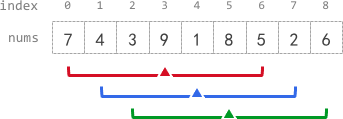原文链接: https://leetcode-cn.com/problems/k-radius-subarray-averages
英文原文
You are given a 0-indexed array nums of n integers, and an integer k.
The k-radius average for a subarray of nums centered at some index i with the radius k is the average of all elements in nums between the indices i - k and i + k (inclusive). If there are less than k elements before or after the index i, then the k-radius average is -1.
Build and return an array avgs of length n where avgs[i] is the k-radius average for the subarray centered at index i.
The average of x elements is the sum of the x elements divided by x, using integer division. The integer division truncates toward zero, which means losing its fractional part.
- For example, the average of four elements
2,3,1, and5is(2 + 3 + 1 + 5) / 4 = 11 / 4 = 2.75, which truncates to2.
Example 1:

Input: nums = [7,4,3,9,1,8,5,2,6], k = 3 Output: [-1,-1,-1,5,4,4,-1,-1,-1] Explanation: - avg[0], avg[1], and avg[2] are -1 because there are less than k elements before each index. - The sum of the subarray centered at index 3 with radius 3 is: 7 + 4 + 3 + 9 + 1 + 8 + 5 = 37. Using integer division, avg[3] = 37 / 7 = 5. - For the subarray centered at index 4, avg[4] = (4 + 3 + 9 + 1 + 8 + 5 + 2) / 7 = 4. - For the subarray centered at index 5, avg[5] = (3 + 9 + 1 + 8 + 5 + 2 + 6) / 7 = 4. - avg[6], avg[7], and avg[8] are -1 because there are less than k elements after each index.
Example 2:
Input: nums = [100000], k = 0 Output: [100000] Explanation: - The sum of the subarray centered at index 0 with radius 0 is: 100000. avg[0] = 100000 / 1 = 100000.
Example 3:
Input: nums = [8], k = 100000 Output: [-1] Explanation: - avg[0] is -1 because there are less than k elements before and after index 0.
Constraints:
n == nums.length1 <= n <= 1050 <= nums[i], k <= 105
中文题目
给你一个下标从 0 开始的数组 nums ,数组中有 n 个整数,另给你一个整数 k 。
半径为 k 的子数组平均值 是指:nums 中一个以下标 i 为 中心 且 半径 为 k 的子数组中所有元素的平均值,即下标在 i - k 和 i + k 范围(含 i - k 和 i + k)内所有元素的平均值。如果在下标 i 前或后不足 k 个元素,那么 半径为 k 的子数组平均值 是 -1 。
构建并返回一个长度为 n 的数组 avgs ,其中 avgs[i] 是以下标 i 为中心的子数组的 半径为 k 的子数组平均值 。
x 个元素的 平均值 是 x 个元素相加之和除以 x ,此时使用截断式 整数除法 ,即需要去掉结果的小数部分。
- 例如,四个元素
2、3、1和5的平均值是(2 + 3 + 1 + 5) / 4 = 11 / 4 = 2.75,截断后得到2。
示例 1:

输入:nums = [7,4,3,9,1,8,5,2,6], k = 3 输出:[-1,-1,-1,5,4,4,-1,-1,-1] 解释: - avg[0]、avg[1] 和 avg[2] 是 -1 ,因为在这几个下标前的元素数量都不足 k 个。 - 中心为下标 3 且半径为 3 的子数组的元素总和是:7 + 4 + 3 + 9 + 1 + 8 + 5 = 37 。 使用截断式 整数除法,avg[3] = 37 / 7 = 5 。 - 中心为下标 4 的子数组,avg[4] = (4 + 3 + 9 + 1 + 8 + 5 + 2) / 7 = 4 。 - 中心为下标 5 的子数组,avg[5] = (3 + 9 + 1 + 8 + 5 + 2 + 6) / 7 = 4 。 - avg[6]、avg[7] 和 avg[8] 是 -1 ,因为在这几个下标后的元素数量都不足 k 个。
示例 2:
输入:nums = [100000], k = 0 输出:[100000] 解释: - 中心为下标 0 且半径 0 的子数组的元素总和是:100000 。 avg[0] = 100000 / 1 = 100000 。
示例 3:
输入:nums = [8], k = 100000 输出:[-1] 解释: - avg[0] 是 -1 ,因为在下标 0 前后的元素数量均不足 k 。
提示:
n == nums.length1 <= n <= 1050 <= nums[i], k <= 105
通过代码
高赞题解
func getAverages(nums []int, k int) []int {
avgs := make([]int, len(nums))
sum := 0
for i, v := range nums {
if i < k || i+k >= len(nums) { // 超过边界
avgs[i] = -1
}
sum += v // 进入窗口
if i >= k*2 {
avgs[i-k] = sum / (k*2+1)
sum -= nums[i-k*2] // 窗口最左边的元素离开窗口
}
}
return avgs
}统计信息
| 通过次数 | 提交次数 | AC比率 |
|---|---|---|
| 4852 | 14202 | 34.2% |
提交历史
| 提交时间 | 提交结果 | 执行时间 | 内存消耗 | 语言 |
|---|




